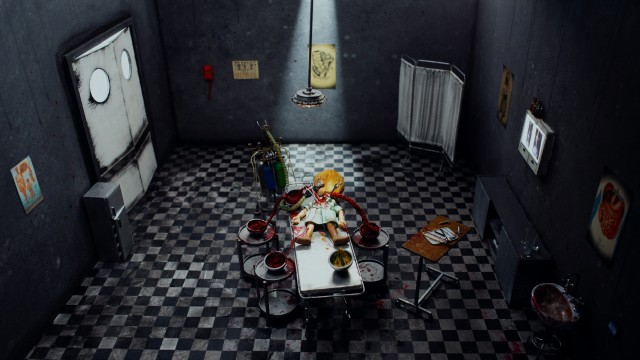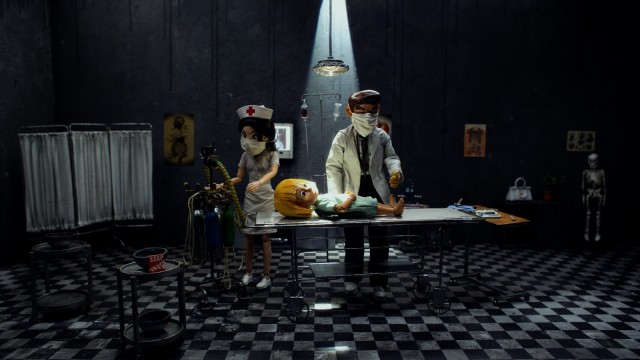Over a year in the making, Tiffany Kimmel‘s stop-motion animation Everybody Goes to the Hospital is a surreal and personal exploration of her mother’s real-life childhood trauma in 1963. Following a young girl named ‘Little Mata’ as she suffers from appendicitis, the film presents a dark and strange visual world, which is all together unsettling and cold. But themes of sickness go beyond the physical as it becomes clear that where there should be love are feelings of resentment. Told through the eyes of a child, Everybody Goes to the Hospital is shockingly heavy, beautifully poetic, and fantastically haunting.
“I wanted to capture the storybook-like quality that I experienced when hearing this story as a child”
Having first encountered Kimmel’s short at last year’s Fantasia, in the coveted Born of Woman shorts block (alongside fellow S/W pick Stained Skin), I can attest to the chilled atmosphere of the theater after the screening. At only 9-minutes long, Everybody Goes to the Hospital is a film that will leave quite the impression on your psyche – and that’s exactly what Kimmel was hoping to achieve. “In making this film, I wanted to capture the storybook-like quality that I experienced when hearing this story as a child”, the writer/director explains. Adding that she also wanted her “mom’s childhood experience to be played out in the doll-like manner she told it, as an unprocessed traumatic fairytale,” whilst also carrying a warning for “others to believe their children and to stay close.”
Having grown up far removed from a “typical” upbringing, Kimmel spent her childhood in a family compound in rural Oregon where she was religiously homeschooled and spent a great deal of time with her family. When she finally left to go to public university, entering the world for the first time, she found that a lot of her impressions of childhood were intimately intertwined with her mother’s. “What she felt, I felt. What she experienced, I experienced. There was little to no distinction in my experience, even though, very obviously, there was a huge gulf of time, space, and actual lived experience”, the filmmaker reveals.

Kimmel says she aimed to create “something that visually reminded me of our humanity but still felt otherworldly and inviting” with her aesthetic.
The film is therefore the true story that both her mother and grandmother would tell Kimmel almost beat-for-beat. This personal connection is what makes Everybody Goes to the Hospital that much more surreal, documenting and dissecting a multi-generational saga of trauma that somehow doesn’t quite feel resolved. Fittingly, the story is told in chapters and ends on an unfinished note, revealing in text that trauma is something that continues to play out and contaminate the present. Coupled with a whimsically melancholy score by McKenzie Stubbert (also a S/W alum having composed the music for Bless Me Father), the film has a nightmarish atmosphere that’s hard to shake off.
Another thing that makes Everybody Goes to the Hospital excel is the small army of heavy hitters in the animation world that contributed to it. For much of Kimmel’s career, she had worked in advertising and documentary as a writer and producer and therefore didn’t quite know how to approach fabrication once she decided on stop-motion animation. But then, the lockdown of 2020 happened and she was given the opportunity to work alongside two Disney Imagineers at a concept design firm where she worked and through that experience she gained the confidence to execute her film. “In many ways, I think writers often give away all of their story power because we don’t know how to manage the different steps necessary to build an entire world – and with this film, I wanted to demonstrate not only that I could but that it could feel like something we’d all already experienced before in some other form as if it were a collective shared experience. A story you already know somewhere deep inside.”
Everybody Goes to the Hospital was made over thirteen months in various quarantine bubbles around East LA or through Twitter outreach. All of the fabrication had to be done remotely and almost every day for five months, Kimmel would go over to the residence of Eric Oxford, the lead animator and fabricator on the short, to work side-by-side (masked) to reset the stage so that they could get the shots (by cinematographer Jordan Holtane) they needed – occasionally dipping last minute yarn into wax to create vomit. Jackie Cadiente worked with Kimmel to create the initial character designs. Oxford and Ange Cox sculpted clay and silicon casts of all the heads of the puppets, and then adjusted the clay sculpts for camera. Chris Alsop saw those initial sculpts, began illustrating them, and evolved the character designs with Kimmel by fusing photographs of the real people, the initial character designs, and the final sculpts through photo realistic pencil drawings.

The attention to detail in the design of EGTTH means it feels both nightmarish and grounded in reality.
“Because we had time, an unheard of luxury in production, I wanted to let everyone influence each other and evolve the characters into their current form,” Kimmel explains, “Coming out of a VFX-heavy job, I wanted to create a physical, practical animation complete with smudges and imperfections baked into the design. Something that visually reminded me of our humanity but still felt otherworldly and inviting. Rich Zim, a claymation legend who worked on The Nightmare Before Christmas, James and the Giant Peach, Rich and Morty (Editors note: and fellow S/W stop-motion The Coin), built my mom’s guts in his home studio during a heatwave.”
The exteriors were a collaboration with one of Kimmel’s former Imagineer coworkers, Hyeun Jason Lee. Lee had been working on Disney theme parks as a concept architect before they met, designing future cities. After work, he would stay on zoom to help develop the blueprints for the hospital and house. He built beautiful plans to hand off to model makers Michael J. Bishop and Mukhtar Kaissi, on leave from the Imagineer shop. Bishop laser cut and made the hospital, while Mukhtar carved the house out of foam blocks and Sculpey clay in his studio apartment bathroom. Needless to say, Kimmel nurtured a wild collaboration of talented individuals.
Alongside that aforementioned Fantasia screening, Everybody Goes to the Hospital also screened at the Brooklyn Horror Film Festival (Special Jury Award), Fantastic Fest, Flickers’ Rhode Island Film Festival and Alameda Film Fest, where it won the Phil Tippet Animation Award. Following the success of EGTTH Kimmel is currently developing a hybrid live-action/stop-motion short film set in post-war London called Heads, a graphic novel following her great-great grandmother’s unconventional life title Pearl Graves and has two documentary projects and several scripts in the works.

 Chelsea Lupkin
Chelsea Lupkin